Stanford launches Living Laboratory Fellowship for Sustainability
In its inaugural academic year, the program is supporting 16 students who are working on interdisciplinary projects that directly contribute to the university’s sustainability objectives.
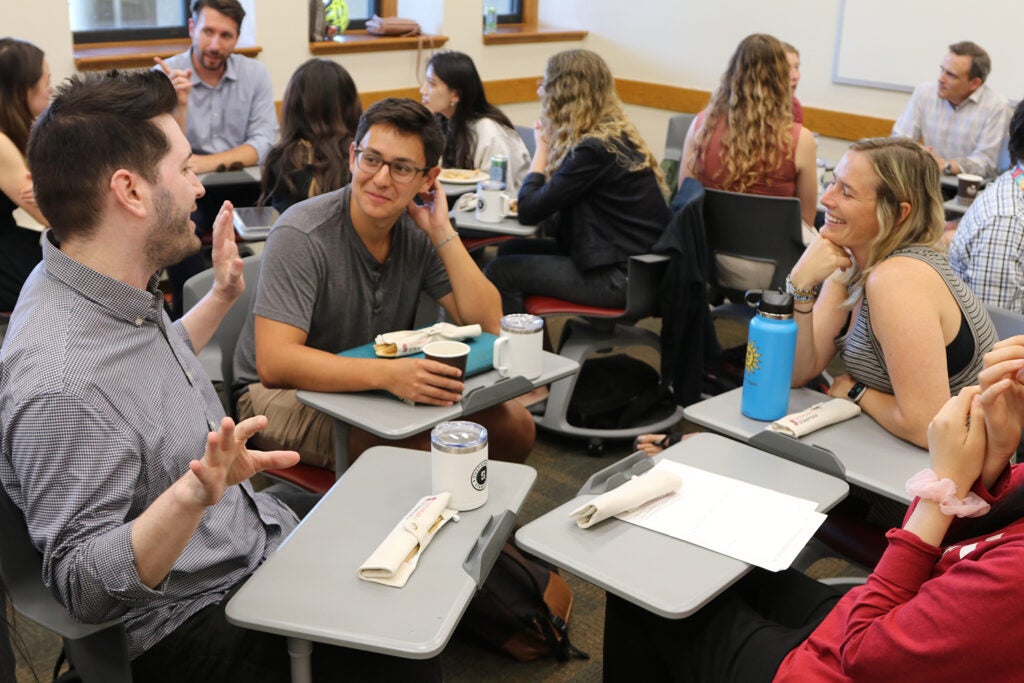
On the left, Living Laboratory fellow Justin West, an undergraduate in computer science, speaks with SUSTAIN 120 classmate Jeremy Rubin, a master’s student in public policy, and operational staff mentor Moira Zbella from Business Affairs, on the right. (Image credit: Oriana Bolden)
Stanford students now have direct opportunities to develop and pilot sustainability ideas via the university’s operations with a cross-disciplinary program that bridges innovation and impact.
With the goal of advancing sustainable solutions on its own turf, the university has launched the Living Laboratory Fellowship Program for Sustainability. Founded in collaboration with the Office of Sustainability, the Stanford Doerr School of Sustainability, and the Bill Lane Center for the American West, the program uses the campus itself as a real-world testing ground, driving the university closer to achieving its operational sustainability targets.
The program is supporting 16 students in its inaugural 2023-24 academic year who are immersing themselves in real-world leadership and project management roles that directly contribute to Stanford’s sustainability objectives. These Living Lab Fellows, who range from undergraduates to PhD students, have been paired with pre-vetted sustainability projects and receive guidance from specialized advisory boards consisting of faculty, industry experts, and other professionals.
“I think we are marking a milestone or an evolutionary step in the way Stanford sustainability is being embodied.”
—Christopher Kuntzsch
Strategy Manager at the Office of Sustainability
“For decades, academics and operations have been partnering to use the campus as a testbed for finding solutions, but historically, these collaborations have been siloed in departments to solve a specific problem,” said Kristin Parineh, director of the Office of Sustainability, which is part of Land, Buildings & Real Estate (LBRE). “A lot of the solutions that we need are campus-wide and cross-departmental – these students are the glue for pulling these stakeholders together to make change occur.”
The initiative takes a holistic approach, recognizing that sustainability is not just a technical challenge but also a social and organizational one. Fellows are participating in Leading Organizational Change for Sustainability (SUSTAIN 120) during fall quarter, which will demonstrate why change fails, teach fellows to avoid common pitfalls, and introduce powerful frameworks and strategic approaches for leading successful change.
“Our students are already some of the most innovative content-area experts in the world; this course simply helps provide the tools and practice they need to better navigate organizations and apply their knowledge,” said course instructor Gretchen Engbring of the Office of Sustainability, who is co-teaching with Bruce Cain, a political science professor in the School of Humanities and Sciences and director of the Bill Lane Center. “It’s a safe space to practice and evolve the skills that will make them effective change leaders during the fellowship and long after in their future careers.”
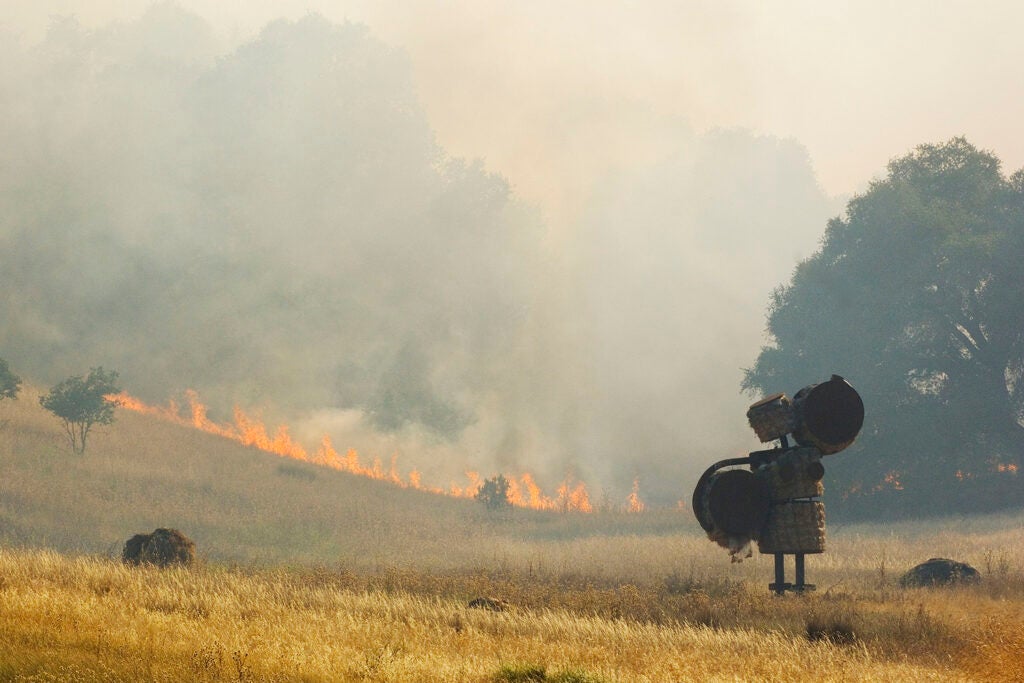
A 2007 grass fire in the Stanford foothills burned about 171 acres. Stanford lands are the subject of projects titled “Carbon Accounting & Sequestration on Stanford’s Natural Lands” and “Planned Fire & Fuels Management on Stanford Lands.” (Image credit: L.A. Cicero)
From fire to food
The projects were selected from a winter 2022 call for proposals based on their potential to benefit operations or serve Stanford’s operational sustainability goals. They include endeavors to reduce the carbon footprint in Stanford Travel/Study, expand zero waste, ensure a just transition for climate planning, manage fire and fuels, enhance campus electric vehicle readiness, develop operational guidelines for sustainability at the Doerr School of Sustainability, and more.
O’Donohue Family Stanford Educational Farm Director Patrick Archie is a partner and mentor in a project to electrify the farm, an innovation testbed on the west side of campus that offers academic and experiential learning opportunities for the Stanford community and beyond. Since the early design phase of the farm, Archie has aspired to have it entirely powered by renewable solar energy to model this potential for small farms around the world.
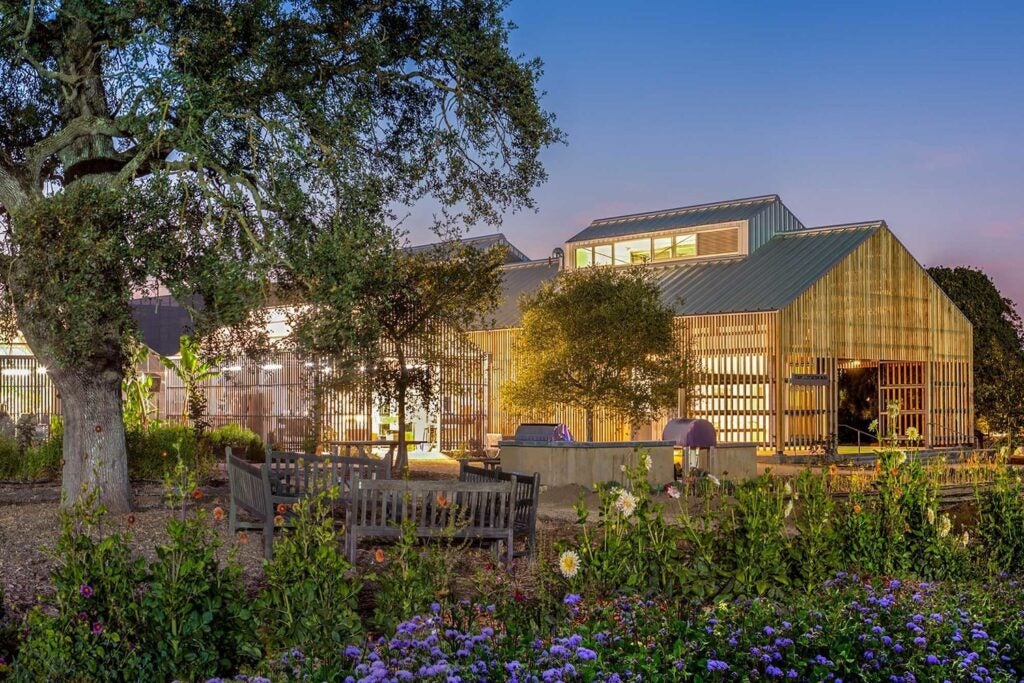
Project participants hope to put solar panels on the roof of the Terry Huffington Barn to power the O’Donohue Family Stanford Educational Farm. (Image credit: Courtesy O'Donohue Family Stanford Educational Farm)
“Our Living Lab fellow will catalyze this project by researching the farm’s current and future energy needs, options for energy system design and applications, as well as electric tractors and other equipment to meet the farm’s production, operations, and land stewardship needs,” Archie said. “A core principle of agroecology is reducing farms’ needs for external inputs of all kinds, creating closed-looped systems that can sustain their communities indefinitely without being dependent on fragile, centralized systems.”
Archie will be guiding the work of fellow Sergio Sánchez, a third-year PhD student in the Emmett Interdisciplinary Program in Environment and Resources (E-IPER). Sánchez expressed excitement that the fellowship will provide him with a well-rounded perspective on the challenges and opportunities related to renewable energy. He sees this as an opportunity to apply theory to practical action and enhance his future career in the field.
“The fellowship will allow me to explore the administrative side of the university while at the same time developing managerial skills that will help me once I am done with my degree,” Sánchez said.
In November, the organizers plan to announce a call for proposals from the Stanford community for the 2024-25 academic year fellowship.
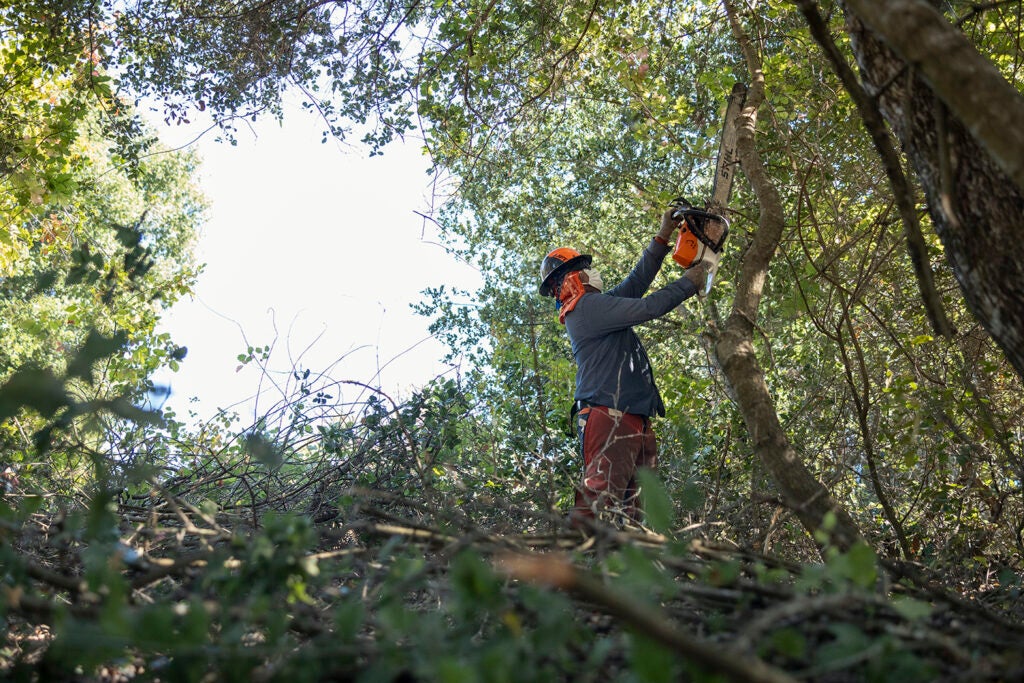
The “Planned Fire & Fuels Management on Stanford Lands” project will focus on Jasper Ridge, with the mentorship of Sheena Sidhu, a stewardship scientist at the preserve. (Image credit: Andrew Brodhead)
Next steps
The program runs through the full academic year and participants will present their results in June. Along the way, they have access to project-specific teams of advisors that include professionals, faculty, and partners in LBRE, the Stanford Alumni Association, the Department of Athletics, Physical Education and Recreation, Business Affairs, Jasper Ridge Biological Preserve, Residential & Dining Enterprises (R&DE), and more. The fellows also benefit from a cross-disciplinary cohort experience and are compensated for dedicating up to 10 hours per week to their projects.
“On our own campus, you see construction going up that can take advantage of the cutting-edge research being done across the street.”
—Christopher Kuntzsch
Strategy Manager at the Office of Sustainability
“I think we are marking a milestone or an evolutionary step in the way Stanford sustainability is being embodied,” said Christopher Kuntzsch, strategy manager at the Office of Sustainability. “There’s a legacy of innovation and success on the operational side and Stanford has created a whole new academic institution around sustainability – it’s a synergy that has incredible potential.”
As an example of how to effectively support university research in conjunction with campus operations, Kuntzsch cited R&DE’s Stanford Food Institute (SFI), founded in 2019 by Shirley Everett, senior associate vice provost for R&DE and senior advisor to the provost on equity and inclusion. The program promotes a holistic approach to improving what people eat, how they access food, and the role that food plays in our lives. In May, SFI hosted its inaugural research symposium, bringing together students, faculty, and staff, along with producers, chefs, and a new generation of entrepreneurs. Researchers spanned the schools of Engineering, Medicine, Business, Law, Humanities and Sciences, and the Doerr School of Sustainability, as well as Stanford Impact Labs, Stanford Health Care, the Scope 3 Emissions Program, SFI, and more.
Another recent project integrates advancements in construction technology into new campus buildings. Here, Stanford’s Center for Integrated Facility Engineering has dedicated faculty and students working on decarbonizing construction. PhD student Eleni Alexandraki was recruited to the Living Laboratory Fellowship Program for Sustainability to bring expertise into Stanford’s Department of Project Management, which oversees major campus construction, Kuntzsch said.
“On our own campus, you see construction going up that can take advantage of the cutting-edge research being done across the street,” Kuntzsch added. “That’s what we are trying to facilitate with this fellowship, is bringing those together.”
Other historical living lab collaborations include the Codiga Resource Recovery Center, a facility that enables pilot testing of promising technologies for the recovery of resources from wastewater, and the COOLER Research Program, which studied the impact of varying building temperature set-points on building efficiency and building-level cooling loads.
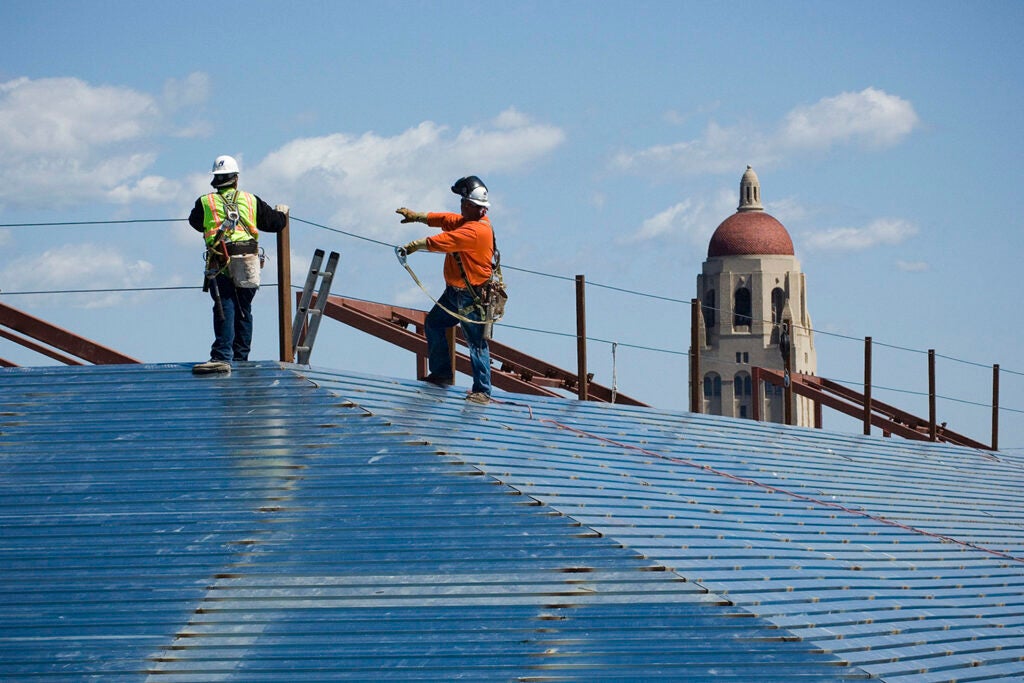
The Jerry Yang and Akiko Yamazaki Environment and Energy Building (Y2E2) under construction in 2007. A Living Laboratory project titled “Reducing Embodied Carbon in Construction” aims to help bridge gaps between research and new buildings on campus. (Image credit: L.A. Cicero)
Common goals
The fellowship program was established as part of a 2023-24 Memorandum of Understanding (MOU) that formalizes collaboration between LBRE and the Doerr School of Sustainability. It aims to “strategically activate Stanford’s campus as a living laboratory to solve challenges that have co-benefits … that drive speed and scale in sustainability innovation, and that develop the next generation of leaders to impact systems change.”
The MOU aligns both entities on project collaborations, reviews, and funding; new construction; Stanford’s climate action planning; communication; and annual reporting. The Living Lab Fellowship is an important first step in that collaboration between academia and operations, which Parineh hopes can be used as an example for other research institutions.
Some of the university’s specific sustainability goals include diverting 90% of campus waste from landfill, reducing Scope 1 and 2 greenhouse gas emissions by 80% by 2025, and eliminating Scope 1, 2, and 3 greenhouse gas emissions by 2050. The fellowship is more than just an academic program; it’s a bridge to a greener future.
“We are advancing the university’s climate and zero waste goals while enriching the student experience and developing the next generation of sustainability change leaders,” Parineh said. “I think it’s powerful for the university and other universities to see how we can create solutions here that can be co-created and scaled.”